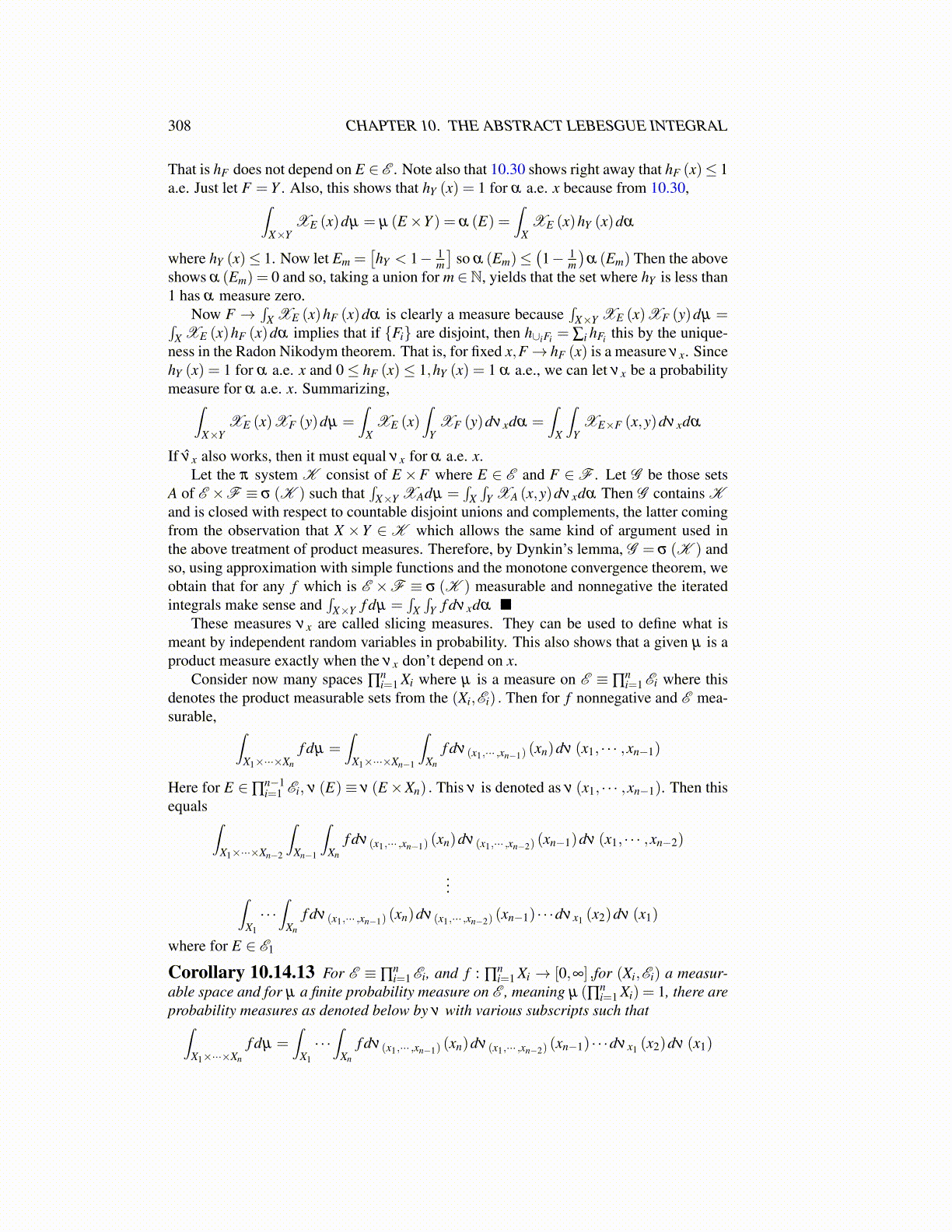
308 CHAPTER 10. THE ABSTRACT LEBESGUE INTEGRAL
That is hF does not depend on E ∈ E . Note also that 10.30 shows right away that hF (x)≤ 1a.e. Just let F = Y . Also, this shows that hY (x) = 1 for α a.e. x because from 10.30,∫
X×YXE (x)dµ = µ (E×Y ) = α (E) =
∫X
XE (x)hY (x)dα
where hY (x)≤ 1. Now let Em =[hY < 1− 1
m
]so α (Em)≤
(1− 1
m
)α (Em) Then the above
shows α (Em) = 0 and so, taking a union for m ∈N, yields that the set where hY is less than1 has α measure zero.
Now F →∫
X XE (x)hF (x)dα is clearly a measure because∫
X×Y XE (x)XF (y)dµ =∫X XE (x)hF (x)dα implies that if {Fi} are disjoint, then h∪iFi = ∑i hFi this by the unique-
ness in the Radon Nikodym theorem. That is, for fixed x,F→ hF (x) is a measure νx. SincehY (x) = 1 for α a.e. x and 0≤ hF (x)≤ 1,hY (x) = 1 α a.e., we can let νx be a probabilitymeasure for α a.e. x. Summarizing,∫
X×YXE (x)XF (y)dµ =
∫X
XE (x)∫
YXF (y)dνxdα =
∫X
∫Y
XE×F (x,y)dνxdα
If ν̂x also works, then it must equal νx for α a.e. x.Let the π system K consist of E×F where E ∈ E and F ∈F . Let G be those sets
A of E ×F ≡ σ (K ) such that∫
X×Y XAdµ =∫
X∫
Y XA (x,y)dνxdα Then G contains Kand is closed with respect to countable disjoint unions and complements, the latter comingfrom the observation that X ×Y ∈ K which allows the same kind of argument used inthe above treatment of product measures. Therefore, by Dynkin’s lemma, G = σ (K ) andso, using approximation with simple functions and the monotone convergence theorem, weobtain that for any f which is E ×F ≡ σ (K ) measurable and nonnegative the iteratedintegrals make sense and
∫X×Y f dµ =
∫X∫
Y f dνxdα ■These measures νx are called slicing measures. They can be used to define what is
meant by independent random variables in probability. This also shows that a given µ is aproduct measure exactly when the νx don’t depend on x.
Consider now many spaces ∏ni=1 Xi where µ is a measure on E ≡ ∏
ni=1 Ei where this
denotes the product measurable sets from the (Xi,Ei) . Then for f nonnegative and E mea-surable, ∫
X1×···×Xn
f dµ =∫
X1×···×Xn−1
∫Xn
f dν(x1,··· ,xn−1) (xn)dν (x1, · · · ,xn−1)
Here for E ∈∏n−1i=1 Ei, ν (E)≡ ν (E×Xn) . This ν is denoted as ν (x1, · · · ,xn−1). Then this
equals ∫X1×···×Xn−2
∫Xn−1
∫Xn
f dν(x1,··· ,xn−1) (xn)dν(x1,··· ,xn−2) (xn−1)dν (x1, · · · ,xn−2)
...∫X1
· · ·∫
Xn
f dν(x1,··· ,xn−1) (xn)dν(x1,··· ,xn−2) (xn−1) · · ·dνx1 (x2)dν (x1)
where for E ∈ E1
Corollary 10.14.13 For E ≡ ∏ni=1 Ei, and f : ∏
ni=1 Xi → [0,∞] ,for (Xi,Ei) a measur-
able space and for µ a finite probability measure on E , meaning µ (∏ni=1 Xi) = 1, there are
probability measures as denoted below by ν with various subscripts such that∫X1×···×Xn
f dµ =∫
X1
· · ·∫
Xn
f dν(x1,··· ,xn−1) (xn)dν(x1,··· ,xn−2) (xn−1) · · ·dνx1 (x2)dν (x1)